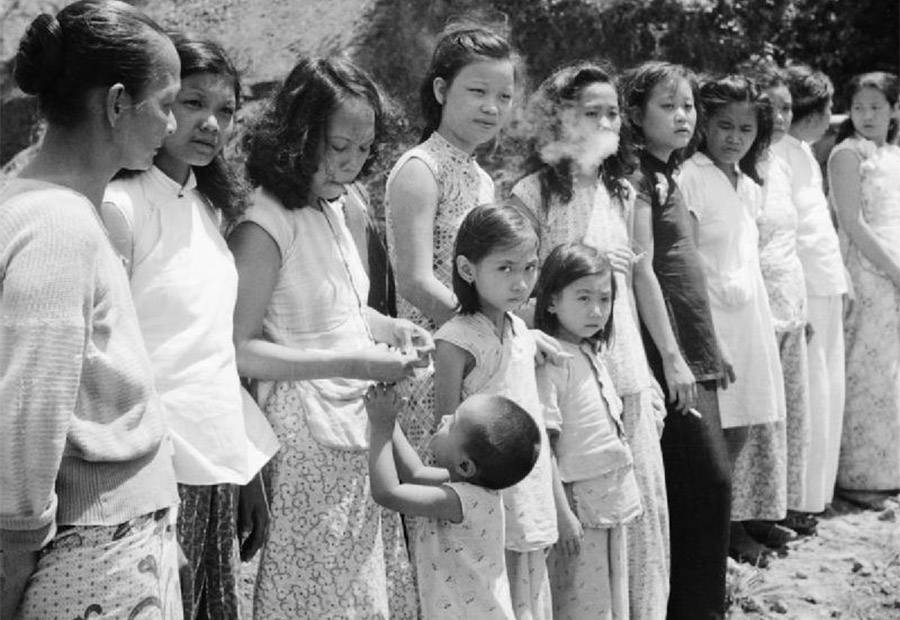Comfort women were women and girls taken from occupied territories by Japan's Imperial Army during World War II and used as sex slaves in what were called comfort stations. Their struggle didn't come to light until decades later.
Though it has been minimized and underplayed, the story of the “comfort women” who worked in Japanese military brothels during World War II is a shocking one that warrants more attention. After all, these women were basically sex slaves.
The first “comfort stations” were set up in 1932 in barracks around continental China, then occupied by Japan.
Since prostitution was legal in Japan at the time, the first comfort stations were thought to contain volunteer prostitutes meant to keep the troops entertained. Many of these licensed prostitution institutions existed in an area called the Dutch East Indies, or present-day Indonesia. Essentially, the first comfort stations were recreations of these legal brothels set up near military bases.
But as the war escalated and Japan conquered and acquired new territory, it turned to enslaving women.
The Imperial Army’s intention when setting up the comfort stations was the desire to restore their image by confining any rape and sexual misconduct to military facilities. It was also a means of keeping military personnel healthy, as soldiers who had previously committed widespread rape when they reached new territories during war typically wound up contracting venereal diseases and other illnesses.

Wikimedia CommonsChinese and Malayan girls taken as comfort women for Japanese troops.
The expansion of more comfort stations for these reasons was carried out after the horrific Rape of Nanking that took place during the Second Sino-Japanese War in 1937 when the Japanese military raped around 20,000 women.
The Japanese military would take women from the areas they were currently occupying, namely Korea, China, and the Philippines. The military would entice them with jobs like nursing the Japanese Imperial Army, cooking, and laundry service.
But in reality, most of the women brought in were forced into sexual services. They became sex slaves who were repeatedly beaten, raped, and tortured.
The military used several tactics to recruit women and girls who would become comfort women.
One such method was deceit. The military would mislead them in regards to what a comfort station was: many Korean women were under the notion that services provided at the comfort stations included tending to wounded soldiers and generally keeping their spirits high.
Another recruitment method involved purchasing young women. The colonies of Taiwan and Korea were poor during the war because Japan had taken any available means of production for the war effort. So desolate families would sell their young women to the recruiters.
Under military authority, a Japanese manager in Burma would buy Korean women for 300 – 1,000 yen, depending on looks and age.
Then there were times where the women were purely taken against their will, abducted by force, with witnesses who saw the recruiters and the army murder family members who attempted to stop them.
As the war got worse for the Japanese Army, it got worse for the comfort women as well. In the summer of 1942, starting with their defeat to the Americans at the Battle of Midway, the Japanese suffered a series of loses. This caused them to retreat from island to island as the Allied forces continued to conquer each one.
The comfort women were taken along with the soldiers. This displaced them from their families and homelands, securing their future as true prisoners with no freedom.
As the war came to an end, the women were either abandoned by retreating troops or stuck with the defeated military and whatever was in store for them.
The Pacific War ended on August 15, 1945. Some women didn’t return to their homes until the late 1990s — long after the war ended. Most didn’t return home at all. It’s estimated that only 25% of the comfort women were able to survive the daily abuse inflicted upon them.
Those who did find their way back faced many health problems, including the inability to have children.
Unfortunately, accounts of Japan’s comfort women and what they went through aren’t well detailed. The Japanese government was reluctant to discuss what these women and girls went through, and many documents pertaining to the women and the comfort stations were destroyed.
In 1992, history professor Yoshiaki Yoshimi found documents at the library of the Japan Self-Defense Agency and made them public. The documents showed clear links between the Imperialist Army and the comfort stations that had been set up.
Only into the late 20th century did survivors of the comfort stations come forward to tell their stories.
One such case was that of Maria Rosa L. Henson. She lived in the Philipines and was raped numerous times by Japanese soldiers before being forced to be a comfort women in 1943 at age 15. It stayed that way for nine months until she was rescued by guerrillas in January of 1944.
In 1992, at 65 years old, she decided to come forward with her story. She was the first Philippine woman to do so. The discovery forced the Chief Cabinet Secretary, Koichi Kato, who had previously denied the government’s involvement in the plight of the comfort women, to come forward and admit their involvement.
Even still, when asked why it took so long for the government to come forward, Kato told the New York Times:
“We did our best. Such problems, unthinkable in a time of peace, occurred in the midst of a war in which behavior often defied common sense. But I have to admit that it took a certain amount of time for us to recognize this problem correctly.”

ROBYN BECK/AFP/Getty ImagesKorean delegates protest what they consider Japan’s inadequate response to the use of Korean and other women as comfort women in World War II, at the United Nations 4th World Women’s NGO Forum. September 2, 1995.
In 2015, while at a press conference with President Obama, Japanese Prime Minister Shinzo Abe was confronted about Japan’s comfort women and was asked if he was willing to apologize. Abe stated:
“I am deeply pained to think about the comfort women who experienced immeasurable pain and suffering as a result of victimization due to human trafficking.”
He added, “This is a feeling that I share equally with my predecessors.”
Speculation about whether Abe’s statement constituted as an actual apology has been debated. It was also reported that Abe set up a one billion yen (or $9 million) fund to help the surviving comfort women and their families.
As the issue has come to light in recent years, “peace movement” monuments have been built in places like Japan, South Korea, the Philippines, and even in Australia and the United States that stand to honor comfort women.
After learning about Japan’s horrifying use of sex slaves during World War II, read about Nancy Wake, World War II White Mouse of the French Resistance. Then, read about history’s most powerful speeches given by women.




